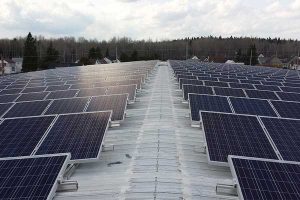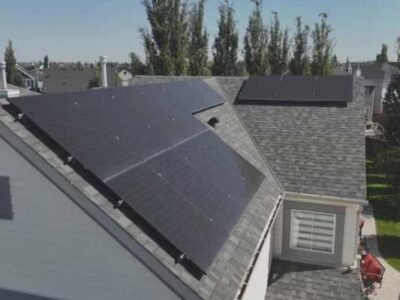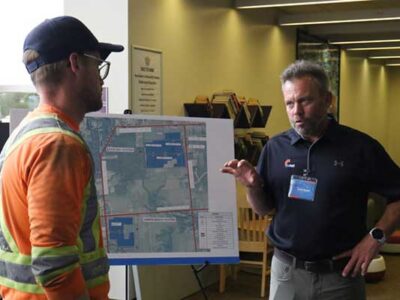- The plan forecasts a 75% increase in electricity demand and proposes the largest nuclear buildout in North America alongside expanded use of rooftop solar and battery storage.
- Industry groups welcomed the long-term planning and focus on distributed energy resources, but cautioned against overreliance on costly nuclear and gas.
- Indigenous communities are being offered expanded roles in energy development through funding increases and equity partnerships, signaling a broader shift in energy participation.
Ontario’s newly released Energy for Generations plan marks a turning point in the province’s approach to energy policy.

Stephen Francis Lecce MPP is a Canadian politician and Ontario’s current Minister of Energy and Electrification. Lecce served as the Ontario Minister of Education from 2019 to 2024. (Image via Ottawa Citizen)
The province’s first-ever Integrated Energy Plan (IEP) lays out a 25-year roadmap to meet rising energy demand—expected to grow by 75%—with a mix of large-scale generation projects, distributed energy solutions, and modernization of the grid.
Minister of Energy and Mines Stephen Lecce called it a “nation-building” blueprint. “This is our generation’s turn to build,” he said. The plan combines electricity, hydrogen, fuels, and storage under a unified strategy—aiming to ensure energy affordability, security, reliability, and emissions reductions.
The stakes are high. Ontario faces the challenge of powering nearly five cities the size of Toronto by mid-century—all while keeping energy affordable and avoiding the pitfalls of emissions-intensive generation.
Big Infrastructure
At its core, the IEP backs a dual-track approach: major investments in centralized generation like new nuclear reactors—including what would be the largest buildout in North America—alongside expanded support for distributed energy resources (DERs). This includes rooftop solar, batteries, smart thermostats, and improved access to net metering.
The government’s intention is clear: keep all doors open, and let a mix of technologies compete to secure Ontario’s energy future. To that end, the plan outlines competitive procurement windows, incentives for clean technology, and new planning mechanisms to end siloed development.
The Canadian Renewable Energy Association (CanREA) welcomed the move. “Transparent, predictable procurement will drive low-cost clean energy investments,” said CEO Vittoria Bellissimo, adding that distributed resources like rooftop solar and battery storage are finally being recognized as vital parts of the energy system.
Pembina Institute’s response, however, was more cautious.
While praising the IEP’s language around DERs and emissions targets, Pembina’s electricity director Scott MacDougall warned that an overemphasis on nuclear and natural gas could crowd out faster, cheaper renewable deployment. “Wind and solar are the lowest-cost options,” he noted, “and scaling them more quickly would help Ontario achieve reliability and affordability sooner.”
The Alberta Parallel
Ontario’s announcement comes amid renewed national debate about energy planning and the pace of transition. Alberta, once Canada’s fastest-growing renewable energy market, has experienced a political and regulatory slowdown. Yet Alberta’s 2023 solar output—over 1.8 million MWh—demonstrated that renewables can meaningfully contribute to the grid without undermining reliability.
Globally, jurisdictions such as California, Denmark, and parts of Germany operate grids with 50–70% renewable penetration. The secret is not more baseload, but smarter systems—enabled by battery storage, flexible pricing, and better transmission planning.
Ontario’s plan gestures in that direction, proposing reviews of net metering, a Local Generation Program, and a DER stream within IESO’s Enabling Resources initiative. These are welcome developments for technology providers and local energy developers, but questions remain about pace, scale, and coordination.
What It Means for Stakeholders

Strathcona Solar 140-kilowatt solar photovoltaic installation on the Virginiatown Community Centre in the Township of McGarry, Ontario. Credit: Strathcona Solar
For investors, utilities, municipalities, and Indigenous communities, the IEP offers both certainty and challenge. The plan commits to long-term procurement and infrastructure investment—offering stability—but also hints at a major shift in how the province values distributed energy and local resilience.
The plan increases Indigenous participation, triples loan guarantees for equity partnerships, and expands funding for the Indigenous Energy Support Program. These moves aim to bring reconciliation into the heart of the energy transition, an effort that could define the success of energy planning in remote and northern regions.
Still, affordability will be the metric to watch. Nuclear builds are decades-long and expensive. Gas carries future carbon and infrastructure risk. And unless procurement windows for solar, wind, and storage are fast-tracked, Ontario risks missing the opportunity to capture low-cost clean energy now.
Fork in the Road
Ontario’s IEP is the province’s most ambitious energy document in decades. It brings long-overdue coordination and makes room for both traditional power generation and emerging technologies. But whether it leads to a cleaner, cheaper, and smarter grid—or locks Ontario into legacy costs—will depend on execution.
The next five years will show if Ontario can align policy ambition with real-world deployment—and if distributed energy will finally move from the margins to the mainstream.













Comments